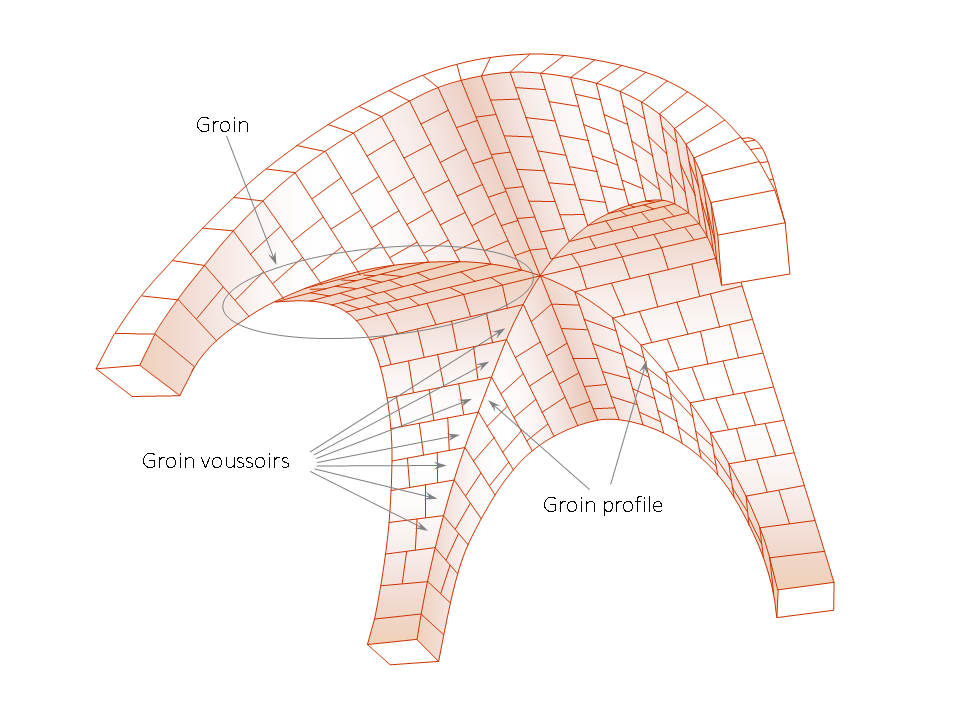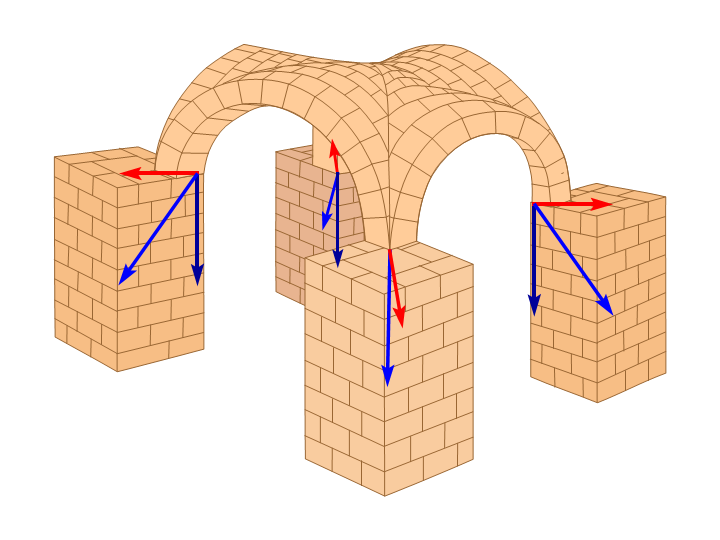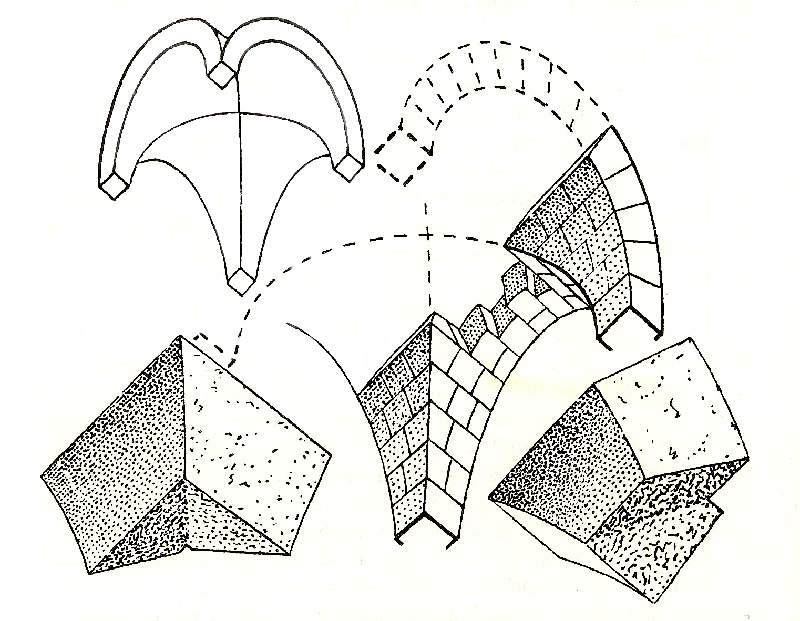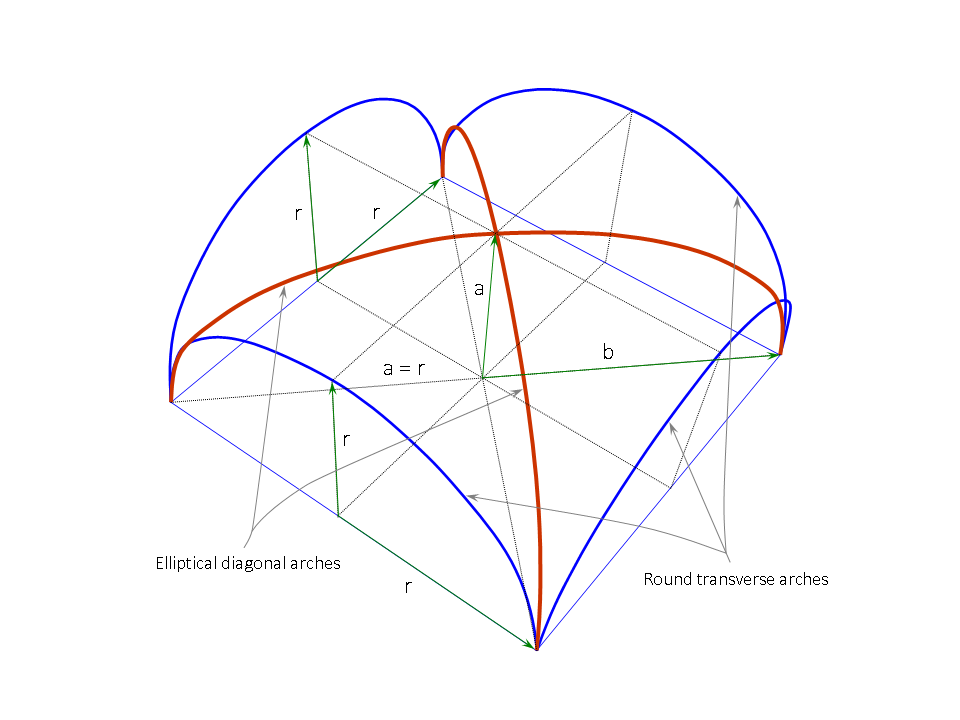Page 3
Cross Vault
Cross vaults, first used by Romans, consist in the perpendicular crossing of two barrel vaults, figure 5.

Figure 5. Cross vault formed by the perpendicular intersection of two barrel vaults.
The basic geometry is that of two cylindrical surfaces intersecting at right angle, figure 6. The profile of the cylindrical surfaces can be round, elliptical, or other ogive.

Figure 6. Perpendicular intersection of two round cylindrical surfaces.
Within the intersection space, the cross vault square area, the vaulting is characterized by four sharp V-shaped corners running along the diagonals of the square. These are vault cusps known architecturally as groins; accordingly, the cross vault is also referred to as the groin vault, figure 7.

Figure 7. Groins, looking up at a cross vault.
The lateral thrusts in a groin cross vault are aligned along the square diagonals and are focused at the four corners of the square. Large pillars are required at the corners as abutments to counter these lateral forces, figure 8.

Figure 8. Groin cross vault with corner piers serving to balance lateral thrusts.
The vault loading forces at the square corners (blue arrows in figure 8) are separated into vertical load forces (black arrows) and lateral thrust forces (red arrows).
The result is that the four sides of the vaulted square area can be open or covered with large windows. Therefore, cross vaults have advantages over barrel vaults, they provide improved illumination of the interior space by natural light. Thus, the long barrel vault for the nave of medieval cathedrals gave way to a series of cross vaults.
One critical issue in the construction of cross vaults is the series of voussoirs along the groin corners, figure 7. The voussoirs along the groins are critical because they are the locus of the lateral thrusts and also serve to tie the webs from the four partitions of the cross vault. These voussoirs are difficult to define. Fitchen notes that the groin voussoirs are stone blocks "no two surface of which are parallel, and four of which are curving," figure 9. (Fitchen 1961, 55-56.)

Figure 9. Shape of groin voussoirs - Fitchen (1961, 55).
All faces of a groin voussoir have different orientation and curvature that stone cutters had to imagine and shape by trial and error, a very challenging task that requires extraordinary masonry skills.
Making the job even more difficult is that the voussoirs along the cusped arches, from spring to crown, are all of different shape, because of the changing curvature along the groins. This is because the intersection of two circular barrel vaults produces elliptical groin curves, figure 10.

Figure 10. Elliptical intersection arches from the crossing of round cylindrical surfaces.
Fitchen shows with graphical illustrations the complex curves resulting when crossing vaults of different shapes and sizes. (Fitchen 1961, ch. 4.)
The diagonal intersection curves become circles when the two intersecting barrels are of the appropriate elliptical cross section. There is a dichotomy in the design of cross vaults: circular barrel vaults produce elliptical curves at their intersection, figure 10, while barrel vaults of the appropriate elliptical and equal shape produce circles at their intersection, figure 11, the circle being a special ellipse.

Figure 11. Circular intersection arches from the crossing of elliptical cylindrical surfaces.
Because of these difficulties, Romans staid primarily with the crossing of equal circular barrel vaults to form cross vaults. Similarly, confronted by the challenges in cross vaulting, Romanesque architecture focused primarily on barrel vaults. Fitchen points out that in the early Middle Ages, in coastal areas of Europe, barrel vaulted churches with heavy walls and few windows also provided good defense from plundering incursions. (Fitchen 1961, 42.)

